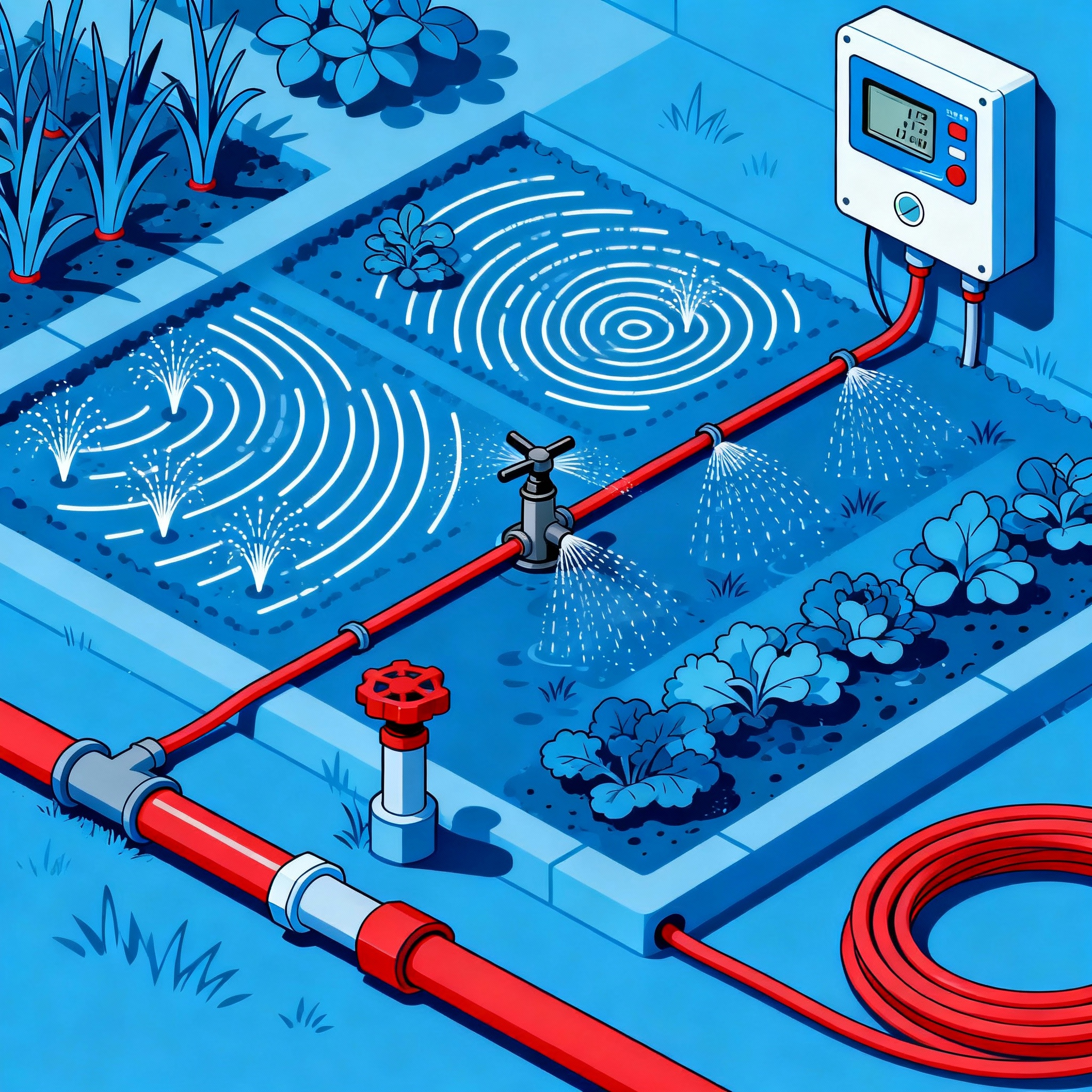Irrigation Run Time Calculator
System Flow Rate Calculator
Irrigation System Types
💧 Drip Irrigation
Efficiency: 90-95%
Best for: Gardens, shrubs, trees, raised beds
Flow rate: 0.5-2 GPH per emitter
Pros
- Very water efficient
- Reduces weeds
- Low pressure needed
- Prevents disease
Cons
- Initial cost higher
- Clogs possible
- Requires maintenance
- Not for lawns
🌧️ Sprinkler System
Efficiency: 65-75%
Best for: Lawns, large gardens, athletic fields
Flow rate: 2-5 GPM per head
Pros
- Covers large areas
- Easy to automate
- Good for lawns
- Adjustable coverage
Cons
- Water waste from wind
- Evaporation loss
- Wets foliage
- Higher water use
🔗 Soaker Hose
Efficiency: 80-85%
Best for: Garden rows, foundation plants, hedges
Flow rate: 1-3 GPM per 100 ft
Pros
- Inexpensive
- Easy to install
- Even watering
- Flexible layout
Cons
- Limited distance
- Visible on surface
- Uneven flow if long
- Degrades over time
💦 Spray Heads
Efficiency: 70-75%
Best for: Small lawns, flower beds, slopes
Flow rate: 8-15 GPH per head
Pros
- Fast coverage
- Affordable
- Various patterns
- Small areas ideal
Cons
- Wind affected
- Misting loss
- Short radius
- Pressure sensitive
🔄 Rotor Heads
Efficiency: 75-80%
Best for: Large lawns, parks, sports fields
Flow rate: 3-8 GPM per head
Pros
- Large coverage
- Uniform watering
- Wind resistant
- Durable
Cons
- Higher cost
- Slower application
- Need good pressure
- Complex install
💡 System Selection Tips
- ✓ Drip for precision: Best water efficiency for gardens and individual plants
- ✓ Sprinklers for coverage: Ideal for lawns and large open areas
- ✓ Soaker for rows: Perfect for vegetable gardens and hedges
- ✓ Consider water pressure: Check your home’s PSI before choosing
- ✓ Budget matters: Balance upfront cost with long-term water savings
- ✓ Mix systems: Use different types for different zones in your yard
Irrigation Calculator User Guide
What It Does:
This calculator helps you design and optimize your irrigation system by calculating precise run times, analyzing flow rates, and comparing different irrigation system types for maximum water efficiency.
How to Use:
⏱️ Run Time Calculator
Calculate how long to run your irrigation system for optimal watering.
- Enter Area to Irrigate:
- Input total area in square feet
- Measure length × width for rectangular areas
- Set Water Requirement:
- Enter inches of water needed per week
- Standard: 1 inch for most plants
- More: 1.5-2 inches for sandy soil or high-demand plants
- Less: 0.5-0.75 inches for established natives
- Input System Flow Rate:
- Enter your system’s GPM (gallons per minute)
- Drip systems: 0.5-2 GPM per 100 sq ft
- Sprinklers: 2-5 GPM per head
- Check manufacturer specs or measure with bucket
- Choose Watering Frequency:
- Once per week (deep watering)
- Twice per week (standard)
- Three times per week (frequent)
- Daily (special needs/containers)
- Calculate:
- Click “Calculate Run Time”
- Results show:
- Minutes per watering session
- Sessions per week
- Total weekly minutes
- Gallons used per session/week
- Set Your Timer:
- Program irrigation controller with calculated minutes
- Schedule for early morning (5-9 AM) best
- Adjust for rainfall
💧 Flow Rate Calculator
Analyze your irrigation system’s performance and coverage.
- Select System Type:
- Drip Irrigation
- Sprinkler System
- Soaker Hose
- Spray Heads
- Rotor Heads
- System Info Displays:
- Efficiency rating automatically shown
- Typical flow rates provided
- Best use cases listed
- Enter Area to Cover:
- Total square footage of irrigation zone
- Count Emitters/Heads:
- Total number of drip emitters or sprinkler heads
- Count all active water delivery points
- Input Individual Flow Rate:
- GPH (gallons per hour) per emitter/head
- Found on product label or manufacturer specs
- Drip: 0.5-2 GPH
- Sprinklers: 1-4 GPH
- Spray heads: 8-15 GPH
- Calculate:
- Click “Calculate Flow”
- Results show:
- Total system GPM and GPH
- System efficiency percentage
- Application rate (inches/hour)
- Time needed for 1 inch of water
- Optimize System:
- Check if coverage is even
- Adjust emitter spacing if needed
- Consider adding/removing heads
🔧 System Types Guide
Compare irrigation systems to choose the best for your needs.
What’s Included:
- Drip Irrigation (90-95% efficient)
- Best for: Gardens, shrubs, trees, raised beds
- Pros: Very efficient, reduces weeds, prevents disease
- Cons: Higher initial cost, requires maintenance
- Flow rate: 0.5-2 GPH per emitter
- Sprinkler System (65-75% efficient)
- Best for: Lawns, large gardens, athletic fields
- Pros: Large coverage, easy automation, good for lawns
- Cons: Wind/evaporation loss, wets foliage
- Flow rate: 2-5 GPM per head
- Soaker Hose (80-85% efficient)
- Best for: Garden rows, foundation plants, hedges
- Pros: Inexpensive, easy install, even watering
- Cons: Limited distance, visible, degrades
- Flow rate: 1-3 GPM per 100 ft
- Spray Heads (70-75% efficient)
- Best for: Small lawns, flower beds, slopes
- Pros: Fast coverage, affordable, various patterns
- Cons: Wind affected, short radius
- Flow rate: 8-15 GPH per head
- Rotor Heads (75-80% efficient)
- Best for: Large lawns, parks, sports fields
- Pros: Large coverage, uniform, wind resistant
- Cons: Higher cost, needs good pressure
- Flow rate: 3-8 GPM per head
System Selection Tips:
- Drip for precision and water savings
- Sprinklers for lawn coverage
- Soaker for vegetable rows
- Check home water pressure before choosing
- Mix systems for different yard zones
Quick Tips:
✅ Measure flow rate – Run system for 15 min, measure output, multiply by 4
✅ Early morning watering – 5-9 AM for best efficiency
✅ Split long runs – Break into cycles to prevent runoff
✅ Adjust for rain – Skip watering after 0.5+ inches rainfall
✅ Match system to plants – Drip for gardens, sprinklers for lawns
Pro Tip: Install a rain sensor on your irrigation controller to automatically skip watering sessions when it rains. This can save 20-40% on water bills and prevents overwatering!

Angelina Everly leads the editorial desk at Live Green Gardens, blending practical plant care, hands-on product testing, and approachable outdoor styling. She focuses on step-by-step how-tos, buyer’s guides, and small-space makeovers that work in real life and real budgets. When she’s not comparing pruning shears or setting up a drip kit, you’ll find her creating cozy corners with planters, solar lights, and pollinator-friendly picks—always with clear pros/cons and safety notes so you can buy once and garden happy.

